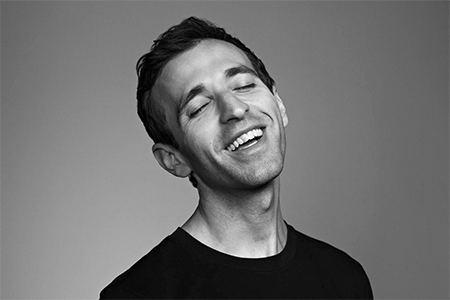by Mike Telin

On Tuesday, October 16 at 7:30 pm in Akron’s E.J. Thomas Hall, Tuesday Musical will present Anthony Roth Costanzo and the Montreal-based Baroque orchestra, Les Violons du Roy, under the direction of Jonathan Cohen. The program will feature works from that debut album: ARC Glass/Handel. Tickets are available online.
Costanzo said that the music of Handel and Glass have similar qualities when it comes to harmonic language and emotional impact, as well as repetition. “Handel has the da capo aria — A and B sections then the A section repeated. He’ll also take lines of text and he’ll chunk them up by repeating a couple of words in that line several times, then he’ll go onto the next set of words and he’ll repeat them a few times. That’s almost exactly what Glass does, except he repeats the music itself.”
Finding the right orchestra for the project was key to its success. And after looking at a number Baroque orchestras or ensembles that specialize in Baroque repertoire, Les Violons du Roy was at the top of the list. “They are so good and I respect them so much,” Costanzo said. “They play with a real dramatic connection to the music. It’s not just clean and excellent, it has blood and guts, and that’s what I’m always looking for in Handel. And the fact that they do play on modern instruments meant that Glass might be a more natural progression for them.”
After Les Violons du Roy agreed to take on the music of Philip Glass, the next step was to approach the composer himself — would he be willing to have orchestral arrangements made for the orchestra using the same group of instruments that would be used in the Handel selections? Glass agreed but told Costanzo to ask Michael Riesman, who is best known as Music Director of the Philip Glass Ensemble and conductor of nearly all of Glass’ film scores, to make the arrangements. “I did and Michael said, let’s do it. And he did an unbelievable job. They work even better than I thought they would, which continues to surprise me.”

Other selections by Glass are “Monsters of Grace” and “1,000 Airplanes on the Roof,” a piece that was premiered in hanger #3 at the Vienna airport. and sung by Linda Ronstadt. “That was not an obvious choice because it was written for synthesizers and is not particularly classical sounding. But when you do it with a 30 plus piece orchestra it’s a completely different experience, and an exhilarating one.”
The recording project also marked the first time that Costanzo had worked with Les Violons du Roy’s new music director, Jonathan Cohen, who succeeded the orchestra’s founding conductor Bernard Labadie. “I had heard a lot about him,” Costanzo said. “I have a lot of friends who have worked with him and everybody said he was fantastic. We spoke on the phone and then I met him in London. When you’re making a solo album, you want to make sure that everybody involved is someone you want to work with. When we met, he was so collaborative and had such good ideas that I knew right away it was going to be a fantastic experience.”

Costanzo’s desire to promote the album in an interesting way led to a collaboration with Visionaire, the New York-based luxury art and fashion multimedia company, to create an hour-long operatic art installation with music. The event featured live painting by George Condo, choreography by Justin Peck with dancer Patricia Delgado, and videos by directors and artists including Academy Award-winner James Ivory, and the production was presented in late September as part of Opera Philadelphia’s O18 festival.
“Because of my background is in theater, film, and dance, I started thinking about how I could collaborate with other artists who are at the top of their field and have their own audiences to bring attention to the album. The project grew slowly but surely with a lot of thought and help. It’s a real labor of love, and I couldn’t believe the level of artists we involved. I think that’s in part because of the music. Everyone was so excited to do something with opera, and to use their art to interpret opera in a new way.”
It’s safe to say that Anthony Roth Costanzo is a model 21st-century artist. How does he encourage students to be as equally diverse? “I stress that in today’s world you have to be creative thinkers and you have to be your own CEO. At some point in your career you can have agents, managers, and publicists, and all of these people help, but they’re all driven by your artistic impulses and ideas, and that’s the important thing.”
Costanzo said that being a good opera singer is more than just singing the music well. “You have to engage the field in new and exciting ways and you have to be reaching outside of the field of opera and receive inspiration from those places. I think that is an important part of our job as opera singers today. That’s what I talk to students about, and I also steal ideas from them all the time. Young people tend to have a different take on culture and they have ideas I haven’t thought of, so I get as much inspiration from them as they do from me.”
Published on ClevelandClassical.com October 11, 2018.
Click here for a printable copy of this article



